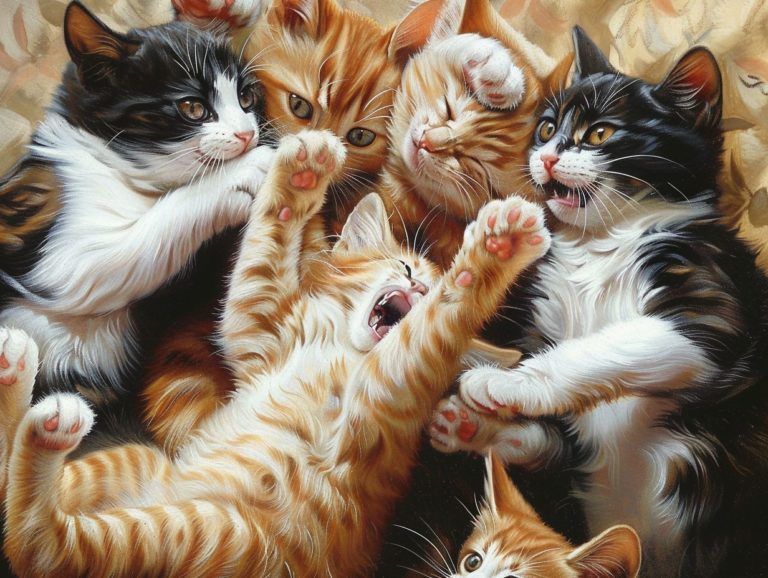Feline Health Plans Indoor Vs Outdoor Cats
This article presents information and insights on whether cats should be kept indoors or outdoors. The ongoing debate on whether cats should be indoor pets or allowed to roam outside has persisted for years.
These articles delve into both sides of the argument, discussing the advantages of keeping cats indoors, the risks associated with letting cats outdoors, and providing suggestions for establishing a secure indoor environment for your feline companion.
Additionally, the articles offer guidance on ensuring the happiness, health, and entertainment of indoor cats while prioritizing their safety.
Key Takeaways:
The Debate: Indoor vs. Outdoor Cats
For many cat owners, the decision of whether to keep their cats indoors or outdoors is a crucial choice influenced by various lifestyle factors, the owner’s environment, and individual values and priorities for their cats’ well-being. Some individuals advocate for keeping cats indoors, citing protection from dangers like traffic accidents, predators, and diseases transmitted by other animals. Conversely, proponents of outdoor access for cats argue that it allows them to engage in natural behaviors such as hunting and exploration, contributing to their overall health and happiness.
Factors such as residing in a city or rural area can sway this decision, with urban settings presenting more hazards for outdoor cats. Ultimately, the choice between indoor and outdoor living reflects the unique values and priorities of each cat owner.
Arguments for Both Sides
Both keeping cats indoors and allowing them outside have their own advantages and challenges that owners need to carefully weigh. Indoor living offers protection from outdoor dangers like traffic, predators, and diseases, reducing the chances of accidents and injuries. It also ensures consistent access to essentials such as food, water, and shelter, fostering healthy eating and sleeping routines.
On the other hand, outdoor exploration fulfills a cat’s natural instincts for hunting, climbing, and socializing, contributing to their mental and physical well-being. However, outdoor cats face risks such as conflicts with other animals, exposure to toxic substances, and the potential of getting lost, all of which pose significant threats to their health and safety.
Benefits of Keeping Cats Indoors
Keeping cats indoors offers numerous benefits, including enhanced health, safety, and overall well-being for cats, particularly crucial in urban settings where outdoor hazards are more prevalent. Indoor living provides a controlled environment that minimizes a cat’s exposure to dangers like vehicle accidents, predators, and toxic substances. This controlled indoor setting reduces various health risks, promoting a longer and healthier life for the cat.
Enriched indoor environments, featuring stimulating toys, scratching posts, and climbing structures, offer mental and physical stimulation for cats. This indoor lifestyle not only ensures a sense of security but also cultivates stronger relationships and bonds with their human caregivers.
Reduced Risks and Health Benefits
Indoor-only cats offer health advantages in addition to safety benefits. These advantages include:
- Reduced risk of disease: Indoor cats are not exposed to potential carriers of infectious diseases such as other animals, parasites, and contaminated outdoor environments. This reduced exposure lowers the risk of indoor-only cats contracting common feline diseases transmitted through contact with infected animals or environments, such as feline leukemia virus or toxoplasmosis. This decreased risk plays a significant role in enhancing the longevity and quality of life of indoor-only cats.
- Regular veterinary care and early detection: The controlled indoor environment of indoor-only cats enables close monitoring and easy access for regular check-ups and veterinary care. This close monitoring results in the health of indoor-only cats being frequently assessed, owners seeking advice from veterinarians for even minor issues before they escalate, and early detection of potential problems in the early stages of the disease.
Risks of Letting Cats Outdoors
Outdoor hazards for cats include traffic accidents, encounters with predators, diseases, parasites, and the potential impact on local wildlife populations. Cats are prone to traffic accidents due to their unpredictable behavior, often darting out into roads unexpectedly. When allowed to roam outside, cats may also face attacks from larger predators like coyotes or various birds of prey. Additionally, outdoor cats are at a higher risk of contracting diseases such as feline leukemia and feline immunodeficiency virus, as well as parasites like ticks and fleas. These health risks not only affect the cats themselves but can also spread to native wildlife populations and ecosystems, emphasizing the need for increased safety and preventative measures to safeguard outdoor cats.
Potential Dangers and Health Concerns
Outdoor cats face various risks such as traffic accidents, encounters with predators, exposure to diseases, parasites, and infections. Therefore, it is essential to manage these health risks in cats through preventive measures and responsible outdoor supervision.
Predators like coyotes and birds of prey pose a significant danger to outdoor cats, especially those allowed to roam freely without supervision. Outdoor cats are susceptible to contracting diseases like feline leukemia and feline immunodeficiency virus from other cats they encounter outside. Parasites such as fleas and ticks can infest outdoor cats, causing discomfort and potential infections.
Providing a secure outdoor retreat with fencing or enclosures can allow cats to enjoy the outdoors safely while reducing the risks of exposure.
Creating a Safe Indoor Environment for Cats
To create a safe indoor environment for cats, it is important to meet their behavioral and health needs while providing mental stimulation to enhance their overall welfare and contentment in an indoor setting.
Indoor cats can become bored and exhibit harmful behaviors if they lack mental and physical stimulation, making it crucial to offer ample opportunities for them to stay mentally active. Utilize interactive toys, games, puzzle feeders, cat trees, and shelves to engage their predatory and territorial instincts, promote physical activity, and keep them entertained.
Regular veterinary check-ups, vaccinations, and parasite control are essential for maintaining a cat’s health and detecting any potential issues early on. Implementing safety measures such as securing windows and removing toxic plants also contributes to creating a secure environment for your feline companion.
Tips for Keeping Indoor Cats Happy and Healthy
The well-being of indoor cats can be ensured by implementing best practices such as providing engaging toys, vertical spaces, interactive playtime, and a balanced diet. Additionally, addressing potential health issues, behavioral needs, and social interactions, especially in multi-cat households, is essential.
To promote mental stimulation for indoor cats, it is recommended to rotate toys regularly to maintain their novelty and interest. Interactive puzzle feeders can engage cats in ‘hunting’ for their food, offering both physical and mental exercise. Regular grooming sessions not only serve as one-on-one time but also provide a bonding opportunity.
Socialization is important for indoor cats, so engaging with adult humans in the family or arranging regular visits from a cat-friendly neighbor or friend can be beneficial. Vertical climbing structures cater to the cat’s natural instinct to climb and provide them with a sense of security in elevated spaces.
Alternatives for Outdoor Stimulation
To prevent boredom and promote physical activity in indoor cats, it is essential to provide alternatives for outdoor stimulation. This can be achieved by offering alternate stimuli such as climbing trees, interactive toys, and easy access to windows for viewing, which provide mental and physical enrichment.
Ensuring that indoor cats have frequent opportunities to exercise and engage in natural behaviors can significantly improve their overall health. Puzzle feeders can stimulate an indoor cat’s hunting instincts, while vertical spaces like cat trees and shelves enable exploration and climbing.
An indoor garden with cat grass and cat-safe plants can offer a sensory experience and an inviting play area for the cat. Cat shelves positioned near windows provide a safe way for cats to observe outside wildlife, offering mental stimulation akin to that experienced by outdoor cats.
Ways to Keep Indoor Cats Active and Engaged
Engaging indoor cats in regular playtime, toy rotation, and providing scratching posts, window access, and potentially a second companion can help reduce behavior issues, provide mental stimulation, and prevent boredom. These activities also ensure that indoor cats remain physically active and content.
Using interactive toys such as feather wands or laser pointers is an effective way to engage indoor cats both mentally and physically. Puzzle feeders and treat-dispensing toys can stimulate their natural hunting instincts and offer mental challenges.
Installing perches or cat trees at various heights in your home provides vertical space for your cat to explore and observe their surroundings from a safe distance. Regular training sessions with positive reinforcement can strengthen the bond between you and your cat, while encouraging learning and physical activity.
Frequently Asked Questions
What is the difference between indoor and outdoor cats?
Indoor cats are kept exclusively inside the house, while outdoor cats have access to the outdoors.
Do indoor cats need a different health plan than outdoor cats?
Yes, indoor and outdoor cats have different needs and therefore require different health plans.
What are the potential health risks for indoor cats?
Indoor cats are at risk for obesity, diabetes, and behavioral issues due to lack of exercise and stimulation.
What are the potential health risks for outdoor cats?
Outdoor cats are at risk for injuries, infections, and exposure to parasites and diseases from other animals and the environment.
Can indoor cats become outdoor cats?
Yes, but it is recommended to slowly introduce an indoor cat to the outdoors and ensure they are up to date on all vaccinations and preventive care.
Can outdoor cats become indoor cats?
Yes, outdoor cats can be transitioned to an indoor lifestyle, but it may take time and patience to adjust to their new environment.



